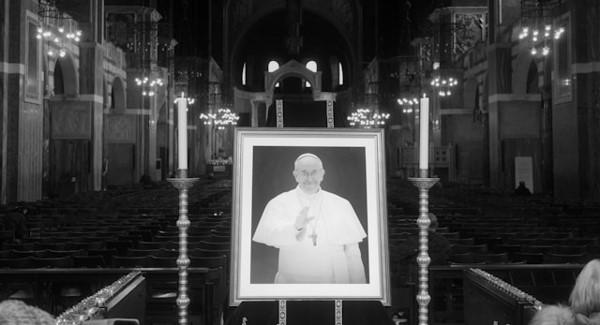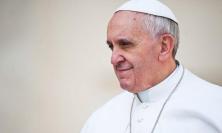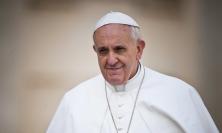Awaiting the thousands of mourners who visit the body of Pope Francis while he lies in St Peter’s Basilica is ‘a sight never seen before’, observes Antonio Spadaro SJ. The pope’s stillness in death is in stark contrast with his vigour in life, which represented his belief in the sacredness of the human body.
The line of the faithful flows in orderly fashion through St Peter’s Basilica and spills out into the square outside. Seen from above, from the Vatican media rooms, the queue moves with a quiet vitality – slow, unceasing. Eyes stretch forward towards a simple wooden box. There lies the body of Francis, clothed in a red chasuble, a white mitre on his head, his hands crossed in prayer over a rosary, one hand slightly raised above the other. He chose not to live in the solemn but grand Apostolic Palace, and he chose not to die upon a catafalque. He abolished, for himself and his successors, the tradition of three coffins – cypress, lead and oak. He decreed that the funeral of a Roman Pontiff should resemble that of a ‘disciple of Christ’, not of a ‘powerful man of this world’.
But this deconstruction of the codes of power had already begun on 13 March 2013, when a new pope appeared at the loggia of blessings in St Peter’s. He was clad entirely in white – not a hint of red, that traditionally imperial colour, the visual expression of the imitatio imperii of the bishop of Rome, justified and sanctioned by the Constitutum Constantini.
With his wishes concerning the funerals of popes, Francis has sealed Christianity’s renunciation of the temptation to inherit the Roman Empire – its political assurance, its glorious legacy. The pope ceases to be the last emperor. His red now signifies only Christ’s passion, the blood he shed, the fire of the Holy Spirit. Mystery, not might.
And so we see him now – laid upon a simple, slightly raised, inclined coffin. On Easter Sunday, for the last time, the popemobile had carried him among the faithful through the paths of the square. Now it is the faithful who traverse those paths, offering their final farewell.
Francis, still – it was a sight never seen before. ‘Rigid Francis’ – an oxymoron that surfaces in the quiet murmur of the line, under the eyes of those who pause just a moment. Yet it is inevitable: in seeing his body turned to stone, one recalls his movement, his capacity to twist and bend, his imbalance. I remember in Rio de Janeiro he was riding in the popemobile towards a gathering with young people, when he realised he had just passed the press area. He arched sharply to the right, risking his balance, simply to wave. And how many times did his hands reach out towards those of the faithful, often carefully avoiding a fall onto the front rows of wheelchair users? Once, in Ecuador, the aisle was so narrow that Francis advanced supported by the hands of those reaching out from either side, gently pushing him forward. He proceeded undeterred, a Chaplin-esque figure, unwilling to resist their touch. For it is touch that most recalls the paternal body of Francis, whom people instinctively longed to embrace – the contact with a masculinity that was at peace with itself. And touch was the sense he never relinquished in his communication with the blind – letting them touch his face, and touching theirs.
His exceeding of boundaries verged on clumsiness; his elegance never equated with stiffness. His body bore the marks of difficulty in walking – and yet it was precisely this excess that defined his posture, his secular reference to transcendence. That it was never mere negligence was attested by the faint scent of old-fashioned cologne that always accompanied him. This unsettled the advocates of a hieratic image of power, of the sacred, of distance, of elevated steps. ‘Do you like my new sedia gestatoria?’ he once asked me before an audience. The ironic pride in that contraption, a sign of new physical weakness, became a symbol of closeness, even more so than his van among luxury sedans. And Francis learned a new kind of plasticity – that of a still body, lifted by the arms of his aides, a body that allowed itself to be carried, no longer under his control. He, who never allowed anyone to act as his bag-carrier. Then there was his walking stick – with curved handle and anti-slip tip – which gave him a slow rhythm, a flickering gait.
History tells us that the body of the pope traditionally constitutes a symbolic device through which to reflect on the staging of the sacred. We understand now, as Francis’ body has assumed an unnatural rigidity, just how deeply he perceived, in the malleable tenderness of the human body, the highest representation of the divine – the very hallmark of his ministry.
Antonio Spadaro SJ is the Undersecretary of the Vatican Dicastery for Culture and Education and the Secretary General of the Vatican Foundation 'All of Us'. He was previously the editor of the journal and a board member of Georgetown University. He conducted the first interview with Pope Francis.






